Europe HVAC Market Size
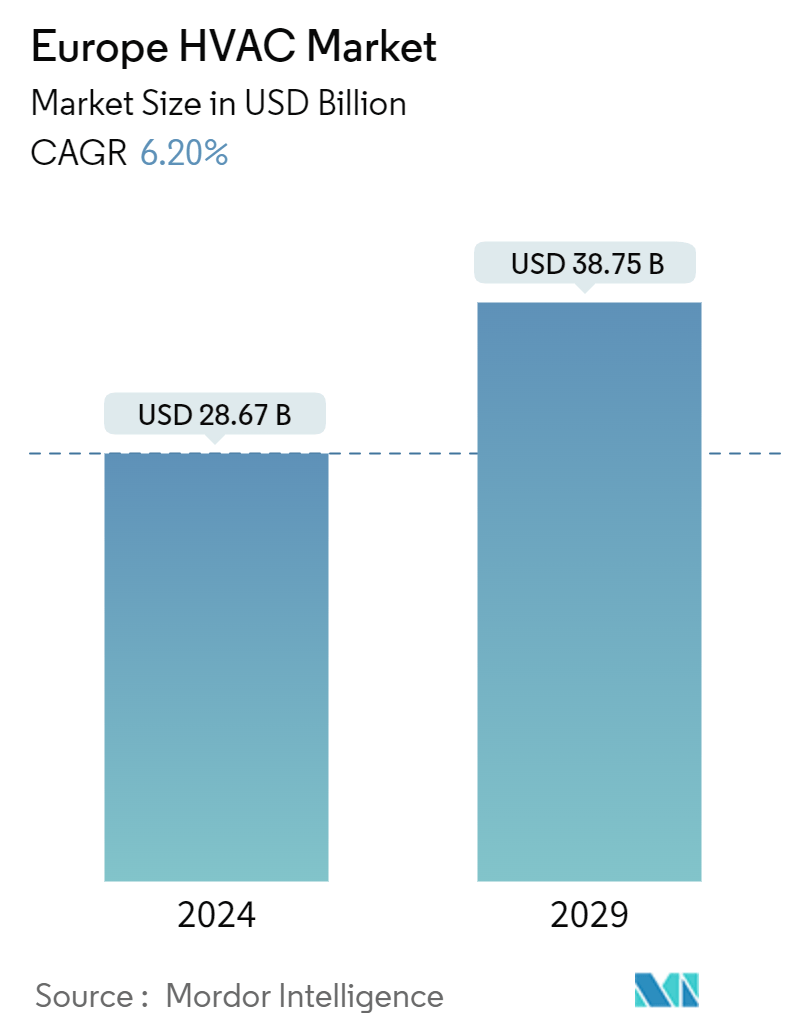
| Study Period | 2019 - 2030 |
| Base Year For Estimation | 2023 |
| Market Size (2024) | USD 28.67 Billion |
| Market Size (2030) | USD 38.75 Billion |
| CAGR (2024 - 2029) | 6.20 % |
| Market Concentration | Low |
Major Players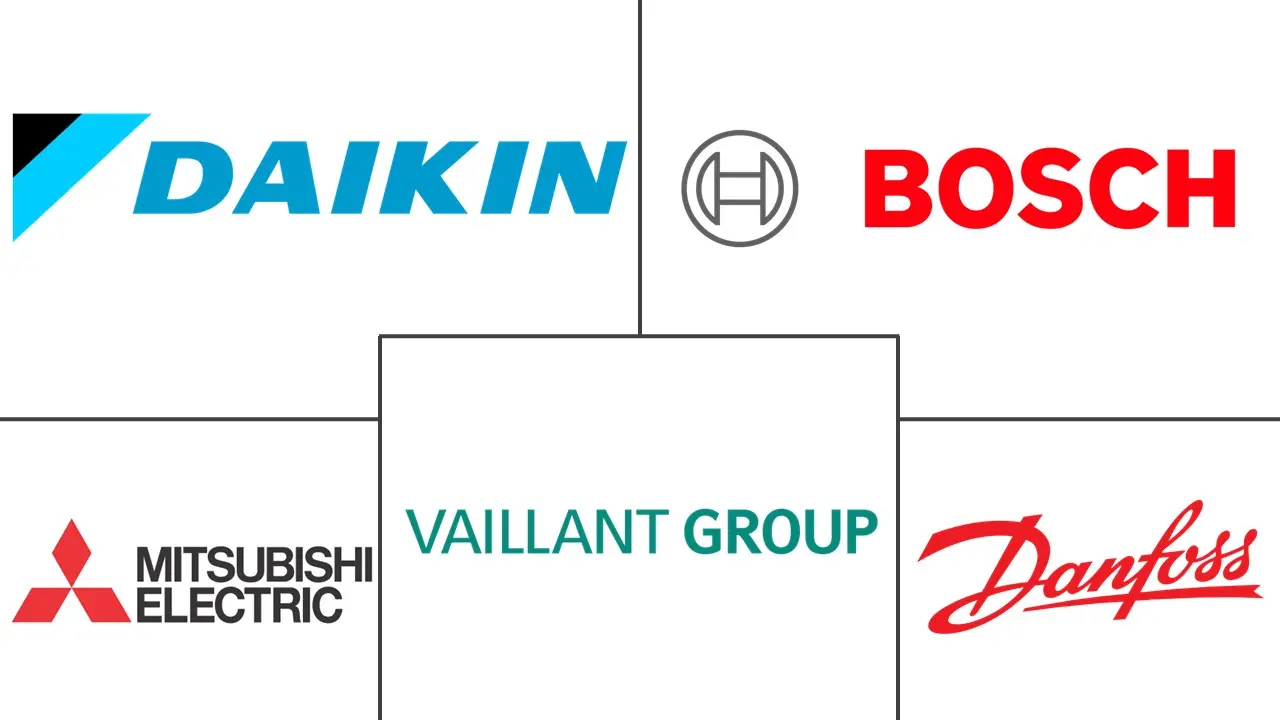
*Disclaimer: Major Players sorted in no particular order |
Need a report that reflects how COVID-19 has impacted this market and its growth?
Europe HVAC Market Analysis
The Europe HVAC Market size is estimated at USD 28.67 billion in 2024, and is expected to reach USD 38.75 billion by 2030, growing at a CAGR of 6.20% during the forecast period (2024-2030).
- Many buildings worldwide, including schools, offices, homes, and factories, still rely on fossil fuels, particularly natural gas, for heating, leading to large amounts of greenhouse gas emissions. Moreover, the current global energy crisis implies that there is an urgent need to move to more affordable, reliable, and cleaner ways of heating buildings. In this context, heat pumps, which can efficiently provide heating to buildings and industries, are one the key technologies to make heating more secure and sustainable.
- According to the IEA, heat pumps have the ability to minimize global CO2 emissions by a minimum of 500 million ton by 2030, equating to the yearly CO2 emissions of all cars in Europe.
- As a result, governments are looking forward to introducing stringent regulations, including mandating the incorporation of heat pumps. This is expected to positively impact the market studied. The European Union also announced the installation of 60 million more heat pumps by 2030, which is in line with the EU targets. This could cut the European Union's gas demand for buildings by 40% by 2030 compared to the 2022 levels and decrease its energy import bill by EUR 60 billion (USD 64.28 billion).
- In March 2023, the European Commission announced key changes to state aid guidelines, which should boost the heat pump sector. The EU wants more relaxed rules on subsidies for specific European sectors to avoid losing out to the Inflation Reduction Act, the US's green technology plan. The sectors include heat pumps and others like wind turbine and battery manufacturing. The European Union has planned to install 10 million heat pumps between 2023 and 2027.
- The industry is heavily controlled by distributors and component suppliers operating in different regions. The raw materials required to manufacture HVAC equipment are electronics, plastics, and compressors. Honeywell is a company that provides AC compressors. The dependence on suppliers for enhanced HVAC systems increases their bargaining power and the production cost of the product. Therefore, the switching cost of these suppliers to other companies is also high. This adds up to the competition in the market, challenging the market's growth.
- The importance of a proper ventilation system was highlighted by the COVID-19 pandemic, and several regional governments have promoted HVAC systems to reduce the spread of the virus. This has boosted the market.
Europe HVAC Market Trends
The Commercial Segment is to be the Fastest-growing End-user Verticals
- The commercial segment involves the use of applied HVAC equipment in commercial buildings and infrastructures, such as restaurants, residential lodges, and small to large shopping complexes and offices. In commercial buildings, semi-custom HVAC equipment is installed wherever the buildings are not uniform and require certain customizations instead of the standard equipment available in the market.
- Heat pumps are an ideal choice for commercial properties as they provide numerous advantages that go beyond conventional heating and cooling systems. Heat pumps excel in enhancing energy efficiency, minimizing operational expenses, and promoting environmental sustainability and decarbonization. By implementing heat pumps, commercial properties can effectively reduce their carbon footprint and actively contribute to sustainability efforts. Embracing these systems is a wise investment that not only improves efficiency and saves costs but also positions commercial properties as pioneers in the shift toward a cleaner and more sustainable energy future.
- Commercial heat pumps have a broad range of applications across different property types and serve various purposes. The growth of heat pumps in commercial settings is anticipated to be further boosted by government efforts. For example, the UK government is actively promoting the adoption of heat pump technology as an alternative to fossil fuel boilers in commercial settings. There are numerous programs accessible to assist UK companies in transitioning to heat pump systems.
- Several companies are constantly investing in introducing various products catering to the demand for these heating systems in the commercial segment. For instance, in November 2023, Daikin disclosed information regarding two upcoming VRV 5 heat pump systems that are scheduled to be released in the first half of 2024. These new systems, namely the Mini-VRV and the Top-Blow series, are designed to cater to the growing demand for decarbonization in commercial buildings. The Mini-VRV system will now offer expanded capacities of up to 33.5 kW, while the new Top-Blow series will reach an impressive 56 kW. With these additions, Daikin is further enhancing its product portfolio to support the transition toward more sustainable and energy-efficient solutions. Such vendor activities are expected to increase the market’s potential.
- The European commercial real estate market was valued at over USD 9 trillion in 2023, according to the European Public Real Estate Association, with Germany, the United Kingdom, and France together accounting for more than 50% of the total market. The commercial real estate market in Germany was valued at USD 1.9 trillion in 2023. Meanwhile, commercial real estate investments in Europe weakened in 2023 compared to 2022. The total commercial real estate investment volume was EUR 253 billion (USD 270.43 billion) in 2022, which dropped to about 133 billion in 2023. Such high investments in the commercial real estate sector should drive the commercial segment's growth in the HVAC equipment market.
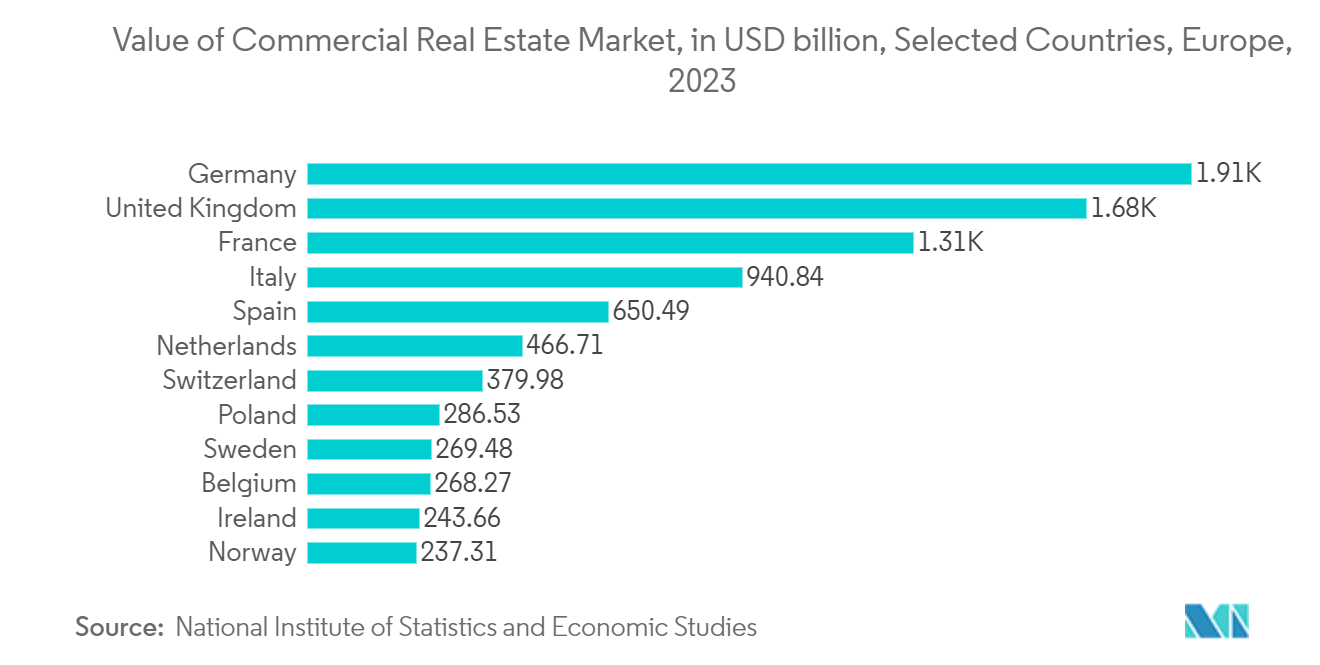
France is Expected to Witness Significant Growth
- The market is expected to witness high growth as France wants to replace residential fuel and gas heaters with heat pumps and create an industry to make the device in a bid to reduce greenhouse gas emissions. The government plans to promote heat pumps as a way to heat houses as part of a multi-year environmental plan.
- The country has approximately 27 heat pump factories, and the government is focusing on increasing the production of heat pumps to meet the growing demand, further driving the market's growth. For instance, in April 2024, the French government announced that the country must produce one million heat pumps before the end of 2027. The plan unveiled by the government has two key elements. Firstly, the government will continue various schemes that help consumers purchase heat pumps, such as 'MaPrimeRénov' and energy-saving certificates.
- Secondly, the government will directly support manufacturers, building on Europe's new openness to support strategic green industries. The French program will support the construction of factories through tax incentives that can amount to up to EUR 200 million (USD 213.41 million) per factory in investment aid.
- According to EUROSTAT, residential construction accounted for 6.80% of France's GDP in December 2022. The Ministère de l'environnementne reports that in 2023, France had approximately 38 million registered dwelling units to accommodate a population of over 67 million. This figure was nearly 33 million in 2008. Additionally, France has consistently built no less than 300,000 new homes per year over the past two decades, with some years reaching approximately 500,000 new homes. As residential construction activities continue to increase, there will be a significant demand for efficient cooling solutions.
- As temperatures are rising worldwide, the demand for air conditioning in France is also increasing. According to EUROSTAT, the revenue from the manufacturing of non-domestic cooling and ventilation equipment in France is expected to be approximately USD 8.584 billion in 2025. Such an increase should support the HVAC market's growth.
- Several players in the market are expanding their presence in the country to increase their market share, supporting market growth. For instance, in April 2024, Mitsubishi Electric Hydronics & IT Cooling Systems SpA and Mitsubishi Electric Europe BV announced that they would acquire AIRCALO. Through this acquisition, the company expects to leverage AIRCALO's broad product line and strong customization capabilities to expand and upgrade its hydronic HVAC systems business in the diversifying European market.
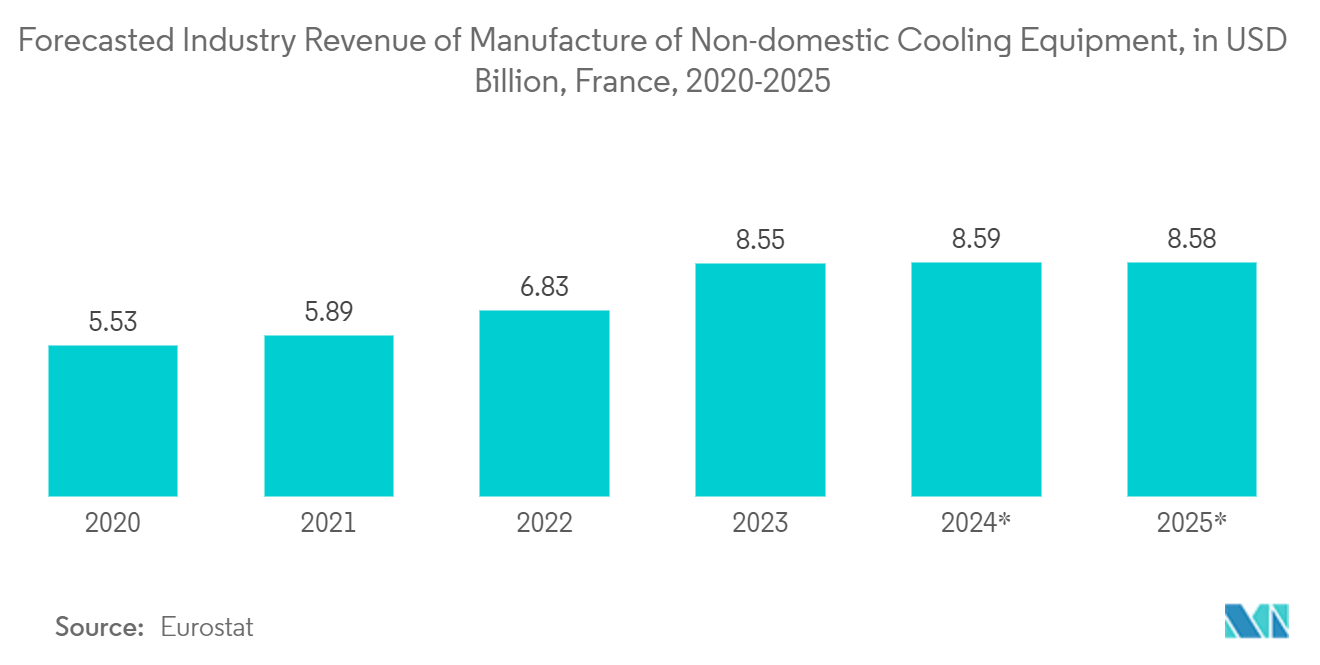
Europe HVAC Industry Overview
The European HVAC market is highly fragmented, with the presence of major players like Daikin Industries Ltd, Robert Bosch GmbH, Mitsubishi Electric Europe BV, Vaillant Group, and Danfoss A/S. The market players are adopting strategies like partnerships and acquisitions to improve their product offerings and gain sustainable competitive advantage.
- April 2024: Daikin Industries Ltd announced the launch of the Stand by Me Certified Partner program, which builds on existing Daikin training through the Daikin Academy. The program provides training on installation safety and quality and allows installers to become certified partners.
- January 2024: Mitsubishi Electric Europe BV announced the release of its residential air-to-water heat pumps. The company's Hydrolution EZY monoblock is able to produce hot water at temperatures of up to 60°C even when outdoor temperatures are down to -25°C. It is available in two power variants: 10 kW and 14 kW.
Europe HVAC Market Leaders
Daikin Industries, Ltd.
Robert Bosch GmbH
Mitsubishi Electric Europe BV
Vaillant Group
Danfoss A/S
*Disclaimer: Major Players sorted in no particular order
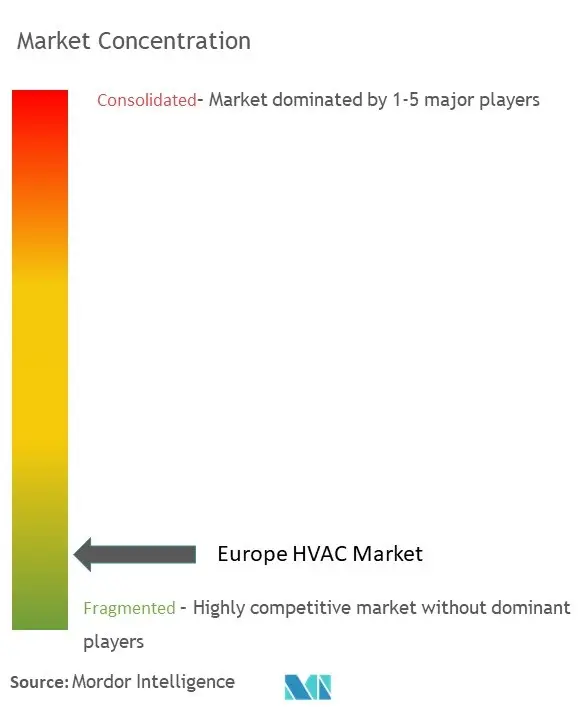
Europe HVAC Market News
- March 2024: Daikin announced the acquisition of BKF Klima in Denmark to drive the region's carbon reduction efforts and expand installer upskilling opportunities. The company will also open two new facilities, a Daikin Installer Training Center and a Daikin Experience Center for consumers, at Daikin's new offices in Brondby, Denmark. This strategic acquisition will enable Daikin to further leverage its extensive research and development expertise in low-carbon HVAC solutions for the region.
- January 2024: Carrier acquired Viessmann Climate Solutions from the Viessmann Group. Through this acquisition, the company will strengthen its position in intelligent climate and energy solutions. The acquisition of Viessmann Climate Solutions strengthens Carrier’s position as a digitally enabled, end-to-end scalable, sustainable energy solutions provider that addresses all renewable, cooling, heating, solar PV, battery storage, and energy management requirements for the home.
Europe HVAC Market Report - Table of Contents
1. INTRODUCTION
1.1 Study Assumptions and Market Definition
1.2 Scope of the Study
2. RESEARCH METHODOLOGY
3. EXECUTIVE SUMMARY
4. MARKET INSIGHTS
4.1 Market Overview
4.2 Industry Attractiveness - Porter's Five Forces Analysis
4.2.1 Bargaining Power of Suppliers
4.2.2 Bargaining Power of Buyers
4.2.3 Threat of New Entrants
4.2.4 Threat of Substitute Products
4.2.5 Intensity of Competitive Rivalry
4.3 Industry Value Chain Analysis
5. MARKET DYNAMICS
5.1 Market Drivers
5.1.1 Supportive Government Regulations Like Incentives for Saving Energy Through Tax Credit Programs
5.1.2 Increasing Demand for Energy-efficient Devices
5.2 Market Challenges
5.2.1 Growing Competition Could Limit Margins
6. MARKET SEGMENTATION
6.1 By Equipment
6.1.1 By Air Conditioning/Ventilation Equipment
6.1.1.1 Single Split/Multi-Splits
6.1.1.2 Variable Refrigerant Flow (VRF)
6.1.1.3 Air Handling Units
6.1.1.4 Chillers
6.1.1.5 Fans Coils
6.1.1.6 Packaged and Rooftops
6.1.1.7 Other Air Conditioning/Ventilation Equipment
6.1.2 By Heating Equipment
6.1.2.1 Boilers/Radiators/Furnace
6.1.2.2 Heat Pumps
6.2 By End User Industry
6.2.1 Residential
6.2.2 Commercial
6.2.3 Industrial
6.3 By Country***
6.3.1 United Kingdom
6.3.2 Germany
6.3.3 France
6.3.4 Italy
6.3.5 Spain
6.3.6 Russia
6.3.7 Denmark
6.3.8 Finland
6.3.9 Iceland
6.3.10 Norway
6.3.11 Sweden
7. GLOBAL MARKET SCENARIO
7.1 North America
7.2 Asia
7.3 Australia and New Zealand
7.4 Latin America
7.5 Middle East & Africa
8. COMPETITIVE LANDSCAPE
8.1 Company Profiles*
8.1.1 Daikin Industries Ltd
8.1.2 Robert Bosch GmbH
8.1.3 Mitsubishi Electric Europe BV
8.1.4 Vaillant Group
8.1.5 Danfoss A/S
8.1.6 Lennox International Inc.
8.1.7 Carrier Corporation
8.1.8 Hitachi Ltd
8.1.9 Ariston Thermo SpA
8.1.10 BDR Thermea Group
8.1.11 Panasonic Corporation
9. MARKET OUTLOOK
Europe HVAC Industry Segmentation
The market is defined by the revenue generated from the sale of heating, ventilation, and air conditioning equipment offered by different market players for a diverse range of end users. The market trends are evaluated by analyzing the investments made in product innovation, diversification, and expansion. Further, the advancements in the construction industry across the residential, industrial, and commercial sectors drive market growth in the studied market.
The European HVAC equipment market is segmented by equipment (air conditioning/ventilation equipment [single split/multi-splits, variable refrigerant flow (VRF), air handling units, chillers, fans coils, packaged and rooftops, and other air conditioning/ventilation equipment], heating equipment [boilers/radiators/furnace and heat pumps]), by end-user industry (residential, commercial, and industrial), and by country (United Kingdom, Germany, France, Italy, Spain, Russia, Nordic Countries, Rest of Europe). The report offers the market sizes and forecasts in terms of value (USD) for all the above segments.
| By Equipment | |||||||||
| |||||||||
|
| By End User Industry | |
| Residential | |
| Commercial | |
| Industrial |
| By Country*** | |
| United Kingdom | |
| Germany | |
| France | |
| Italy | |
| Spain | |
| Russia | |
| Denmark | |
| Finland | |
| Iceland | |
| Norway | |
| Sweden |
Europe HVAC Market Research FAQs
How big is the Europe HVAC Market?
The Europe HVAC Market size is expected to reach USD 28.67 billion in 2024 and grow at a CAGR of 6.20% to reach USD 38.75 billion by 2030.
What is the current Europe HVAC Market size?
In 2024, the Europe HVAC Market size is expected to reach USD 28.67 billion.
Who are the key players in Europe HVAC Market?
Daikin Industries, Ltd., Robert Bosch GmbH, Mitsubishi Electric Europe BV, Vaillant Group and Danfoss A/S are the major companies operating in the Europe HVAC Market.
What years does this Europe HVAC Market cover, and what was the market size in 2023?
In 2023, the Europe HVAC Market size was estimated at USD 26.89 billion. The report covers the Europe HVAC Market historical market size for years: 2019, 2020, 2021, 2022 and 2023. The report also forecasts the Europe HVAC Market size for years: 2024, 2025, 2026, 2027, 2028, 2029 and 2030.
What are the key drivers of the Europe HVAC Equipment Market?
Key factors driving the European HVAC Equipment Market include a) Rising demand for energy-efficient HVAC systems b) Stringent government regulations on energy usage c) Growing construction industry in Europe
Europe HVAC Industry Report
The HVAC equipment market in Europe is witnessing significant growth, fueled by the demand for energy-efficient and innovative systems across various sectors. With a focus on sustainability and IoT integration, the market is evolving towards smarter solutions. Rising temperatures and climatic changes have increased the need for advanced air conditioning and heating, spotlighting heat pumps for sustainable heating. The market caters to heating, ventilation, and air conditioning equipment, with the commercial sector experiencing rapid expansion due to affordable, dynamic HVAC systems. This growth is supported by an emphasis on renewable energy and favorable government policies, although challenges like high installation costs and the need for skilled technicians remain. HVAC companies in Europe are innovating and focusing on energy efficiency to meet market demands. For detailed insights, Mordor Intelligence™ offers a comprehensive analysis, including market share, size, revenue growth, and a forecast outlook, available as a free report PDF download.
